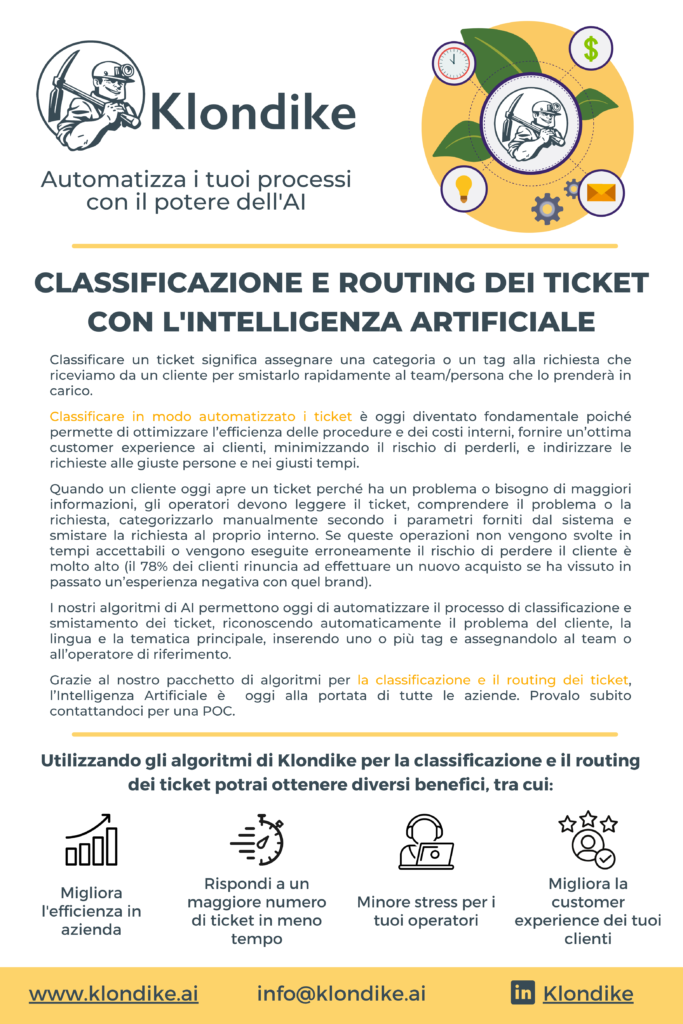It has never been easier for customers to get in touch with companies – on social media, in-app surveys, review sites, email, chat – at any time of the day, wherever they are. If through all these channels the customer has a good customer experience, the brand will get a good loyalty, increasing sales and generating a positive word of mouth. However, many companies do not have effective workflows that can help provide the experience that their customers expect.
To meet all these demands, most companies use help desk software to manage customer requests. Within these software, however, many processes remain manual or automated in a simplistic way. An example of these processes is surely the classification of tickets that is often left to the operator or automatic tags are inserted by keyword.
Although this removes some of manual work, ticket classification systems in help desk software are quite simple and, in many cases, is assigned the tag “other” or a large tag that does not describe the problem in detail. The result is that in the help desk almost 30-40% of tickets are not sent to the right team.
As well as classification, routing of tickets is a process that many companies fail to perform properly.
The truth is that business processes are easy to solve if you have the right tools. And it’s here that Artificial Intelligence (AI) can aid, allowing us to classify tickets and route them to the most suitable pool of agents in a quick and effective process.
In this article we explain what are classification and routing of tickets, and how Artificial Intelligence can help us.
Tickets classification
When a support ticket is opened, it must be processed and one or more tags (or categories) are assigned so that is sorted to the correct team member. If this process is done manually, agents often end up assigning to tickets the tag “other” to keep up and perform this boring task faster.
This hasty (and most often incorrect) classification, in addition to not solving the problem or the request of customers, could be decisive in the abandonment by the customers themselves.
Rules-based ticket classification systems are not entirely accurate or efficient. For each individual customer it would be necessary to rewrite new rules and actions each time. If a new problem occurs, a rule-based system will not recognize it immediately, which means that new problems will not be marked immediately. If they are urgent, and they are not resolved, this may cause customers to quit.
The classification of tickets with machine learning solves this problem, since algorithms of NLP (Natural Language Processing) are able to interpret the contents and categorize them, learning each time and determining the actions to be taken, without human intervention.
In this way tickets can be sorted quickly to the team member or department, based on tags such as language, topic, channel or urgency.
Here are some of the advantages of classifying tickets with AI:
- It saves time and avoids burdening team members with boring and repetitive tasks.
- Ticket categorization algorithms work 24/7, so they can respond in real time at any time of the day.
- Thanks to machine learning, the machine learns from acquired data and becomes more and more precise.
The routing of tickets
Ticket routing is the process of routing incoming requests to the best-equipped team members to handle them. As in the case of ticket classification, this process is done manually in most cases: this therefore requires a lot of time and often leads to bottlenecks and long response times, as well as a waste of time by the team.
To save agents valuable hours of work, and allow them to focus on solving customer problems, the solution is still using AI in the business processes of ticket routing. A correctly sorted ticket will arrive in the right hands at the right time, with positive impacts on resolution times and customer satisfaction.
Some of the advantages of automatic ticket routing are:
Support tickets are instantly directed to the most appropriate person or team, reducing response and resolution times and increasing efficiency and productivity. In addition, thanks to machine learning, the machine will learn from data and previous examples and will be increasingly accurate.
If done manually, this process takes a lot of time and therefore is expensive (especially if you have to handle large volumes of tickets every day). With automatic routing, however, you can analyze large amounts of tickets in real time.
Your agents, saving valuable time, can focus on problems that require more personalized responses or more “human” interactions. Customers will certainly remain more satisfied.
As for classification, ticket routing algorithms also allow you to categorize requests based on attributes such as topic, language or channel, but also considering the ability of your agents or depending on the size of your customers.
Ticket classification and routing with AI: what are the advantages?
The classification and routing of tickets allows you to improve the customer experience and at the same time the quality of the work of your agents. Let’s get some numbers:
- At least 10% reduction in agents’ labour costs.
- Lower stress for your operators who will no longer have to perform mechanical and repetitive tasks with low added value and greater business efficiency.
- Improvement in the quality of customer experience, reflected in a faster resolution of customer problems (by 20% to 80%) and in an increase in the total corporate level of customer satisfaction CSAT (by 10% to 25%).
Fill out the form and download now the information pdf dedicated to this business case








